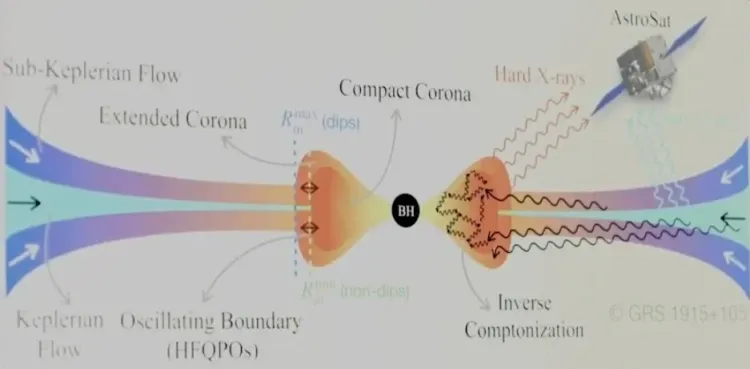How Did ISRO and IIT Guwahati Scientists Decode Flickering X-ray Signals from a Distant Black Hole?

Synopsis
Key Takeaways
- ISRO and IIT Guwahati collaborated on a significant discovery.
- The X-ray signals from the black hole reveal its growth patterns.
- AstroSat played a critical role in observing the flickering signals.
- These findings enhance our understanding of black hole dynamics.
- The research may change our perspective on galaxy evolution.
New Delhi, Aug 18 (NationPress) A collaborative team of researchers from the Indian Space Research Organisation (ISRO) and the Indian Institute of Technology (IIT) Guwahati has decoded a perplexing pattern of X-ray signals emitted by a distant black hole situated approximately 28,000 light-years away from our planet.
The team, which included scientists from Haifa University in Israel, analyzed the X-ray brightness of the black hole GRS 1915+105 utilizing data from India’s space observatory AstroSat.
They discovered that the signals fluctuated between bright and dim intervals, each lasting several hundred seconds.
This groundbreaking finding enhances our understanding of how black holes evolve and influence their cosmic surroundings.
“Our research provides concrete evidence for the cause of X-ray flickering. We have determined that this flickering correlates with variations in the corona that envelops the black hole,” stated Dr. Anuj Nandi from the U. R. Rao Satellite Centre at ISRO.
“We have observed the first instance of rapid X-ray flickering, occurring roughly 70 times per second (around 70 Hz), during the high-brightness phases of the source. Interestingly, these rapid flickers vanish during the low-brightness phases. This new insight was enabled by the powerful and unique observational capabilities of AstroSat,” added Prof. Santabrata Das from the Department of Physics at IIT Guwahati.
The findings, published in the journal Monthly Notices of the Royal Astronomical Society, indicate that the X-ray brightness from the black hole alternates between two distinct phases: one bright and one dim.
During the brighter intervals, when flickers are most pronounced, the corona becomes more compact and significantly hotter. Conversely, in the dimmer phases, it expands and cools, leading to the disappearance of the flickers. This clear connection suggests that the compact, oscillating corona is likely the source of these rapid signals.
While each phase persisted for several hundred seconds and followed a regular pattern, the rapid flickering signals only emerged during the brighter phases. This discovery reveals that the corona surrounding the black hole is not a static entity and alters its shape and energy based on the flow of gases into the black hole.
The study offers a deeper insight into the extreme gravitational forces and high temperatures present near a black hole’s event horizon. These results also refine our models of how black holes grow, emit energy, and interact with their environment.
Moreover, it provides clues about how black holes might impact the evolution of entire galaxies.










